#nikonos project
Explore tagged Tumblr posts
Text

月桃腰腹 093/365
19 notes
·
View notes
Text
🃏 4.2k words
🎨 nikonoe / kononika / このにか
🃏 e rated; domestic au, role reversal
hello cloquesta nation… i am back and worse than before…
#clock over orquesta#cloquesta#nika sakurakoji#nika sakurakouji#konoe kokonoe#nikonoe#kononika#nikakonoe#このにか#nika x konoe#konoe x nika#clqst#kinktober#kinktober 2024
1 note
·
View note
Photo

Mi Nikonos V sigue en cuarentena.
269 notes
·
View notes
Text



Wishing I was at the ocean instead of my office job.
Instagram | Website
#southern california#personal#shoot film#35mm#stay broke shoot film#ocean#pacific ocean#film photography#filmisnotdead#the ocean is calling#huntingtonbeach#California#underwaterphotography#nikonosiv#nikonos#nikonos project#daydream
2 notes
·
View notes
Text

#nikonosiii#surfing#surf#film#35mm film#ocean minded#california#surf travel#san francisco#nikonos project#nikonos
115 notes
·
View notes
Photo




Nikonos
30 notes
·
View notes
Photo

© Brooks Sterling
3 notes
·
View notes
Photo

long waits
26 notes
·
View notes
Video
828-47 by Ben Soto
#Ben Soto#Nikonos III#35mm Nikkor Lens#Nikonos Project#Blackies Beach#Newport Beach#Orange County#California#CA#Hurricane Marie#surfing#surf photography#surfer#surf#wave#believeinfilm#35mm film#C-41
6 notes
·
View notes
Text

いじぬや〜やうねりに乗っかって 064/365
アダンのトンネルを抜けて、ビーチに降り立つと、白鷺が砂浜にいた。僕が近づくと、その白鷺は羽ばたいて飛び去っていった。
少し柔軟体操をして、サーフボードに乗り込み、朝焼けの中、ブレイクポイントに向かった。でも、波はブレイクせず、ただのうねりだけの波がいくつかあったので、それをキャッチしてサーフィンを楽しんだ。
波待ちをしていると、酉龍権現(洞窟)に何か白いものがあるのが見えた。最初は漂着した発泡スチロールかなと思ったけど、それは最初にビーチでみた白鷺だった。
何となく「こっちにおいで」と呼ばれている気がして、そのまま酉龍権現に向かってパドルした。近づいてみると、岩の色と同じような黒鷺も一緒にそこにいることに気づいた。
そして、僕がさらに近づくと、白鷺と黒鷺は酉龍権現から朝焼けの中に向かって羽ばたいていった。とてもうつくしい光景だった。
サーフボードが流されないようにリーシュを岩に絡めて、初めて洞窟の中に入ってみた。
そこは、大地と海が一つになったような、気持ちの良い場所だった。


8 notes
·
View notes
Text
rising from the dead… hi cloquesta nation… i wrote a nikonoe fic
#clock over orquesta#cloquesta#clqst#nika sakurakoji#nika sakurakouji#konoe kokonoe#nikonoe#kononika#🕑🕘#🕘🕑#nikakonoe#wow jp fans have lots of names for them
1 note
·
View note
Text

Perdí el enfoque mientras sujetaba el tablón.
26 notes
·
View notes
Text
10 portrait inspiration
Masahisa Fukase was born in the town of Bifuka in the Nakagawa District, Hokkaido, Japan in 1934, the son of a successful local studio photographer. He graduated from Nihon University College of Art’s Photography Department in 1956, and became a freelance photographer in 1968 following brief stints at the Nippon Design Center and Kawade Shobo Shinsha Publishers. In the mid 1970s he set up a photographic school, The Workshop, with Daido Moriyma and Shomei Tomatsu.
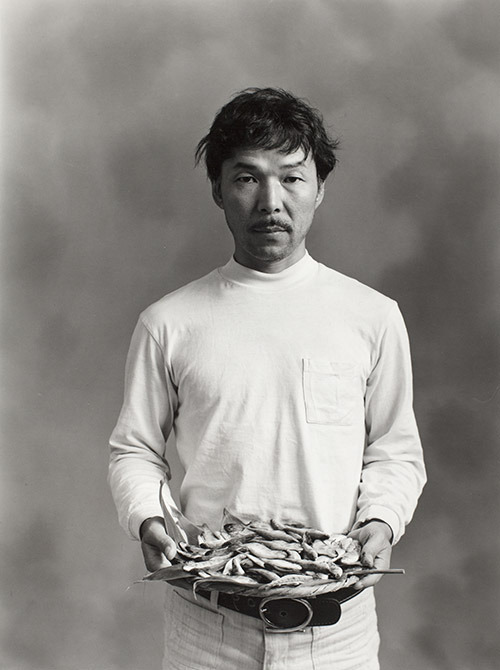
Fukase is considered as one of the most comprehensive and experimental photographers of the post-war generation in Japan. He became world-renowned for his photographic series and ensuing publication Karasu made between 1975 and 1982 in the wake of his wife Yōko Wanibe divorcing him. The visual narrative of the series revolves around the anthropomorphic form of the raven, which is widely celebrated as a photographic masterpiece. And yet a majority of his work remained largely inaccessible to the public for over two decades. In 1992 Fukase developed permanent brain damage after a tragic fall, and it was only after his death in 2012 that his archives of work were gradually disclosed to the public. Since then a wealth of material has surfaced that had never previously been shown.
His work has been exhibited widely at institutions such as MoMA, New York, the Oxford Museum of Modern Art, the Foundation Cartier pour l’Art Contemporain, and the Victoria & Albert Museum London. His work is held in major collections including the Victoria & Albert Museum, the San Francisco Museum of Modern Art, the Metropolitan Museum of Art, New York, and The Getty Museum. He is also the winner of prizes including the 2nd Ina Nobuo Award, as well as the Special Award at the 8th Higashikawa Photography Awards.

At a first glance, Masahisa Fukase's Bukubuku might feel like an amusing , diverting, however shows a darker take on the self portrait. childhood memories of playing around in the bathtub. However, delving deeper into his biography, the black and white images of the Japanese photographer, taken in 1991, alone and submerged in his bathtub are symbolic of the isolation and loneliness he felt at the time.

Once a primary focus of his work, his marriage to second wife Yōko Wanibe, gaining him recognition as a photographer who only photographed his wife and reflecting on this again aafter his divorce on in his work Karasu.
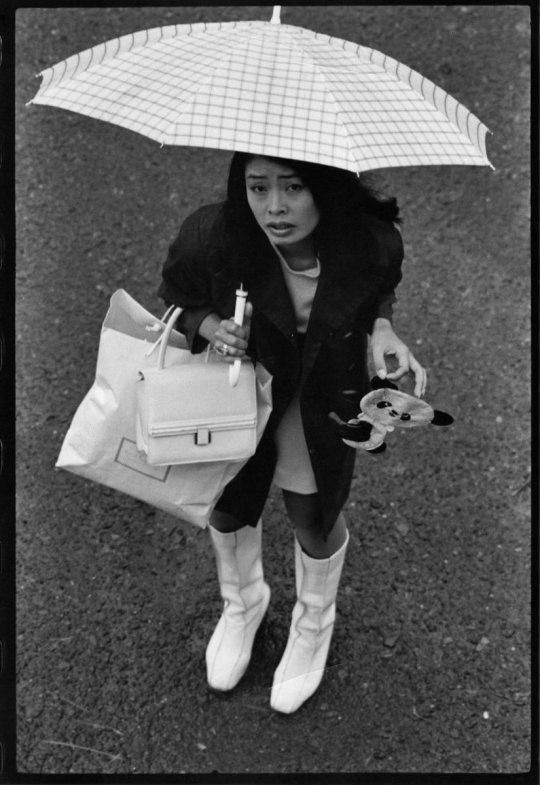
Each individual project made by Fukase has a totally different matrix and subject. He did not use the same printing styles nor photography techniques for each project. This is most unusual and it is one of the elements that makes him so very special,” says Hoppen. Explaining his fascination with the work, which took him eight months to acquire, he explains, “I initially found myself being reminded how similar the Japanese and British sense of humour is (when viewing Bukubuku). The work seemed flippant and comical. But on closer inspection and after speaking to many close acquaintances of Fukase, I learnt that he saw this very much as a performance piece of work and this it was shaped by Fukase as an introspective and mournful soliloquy to his ex-wife Yoko, just after he learnt that she had gotten remarried.”
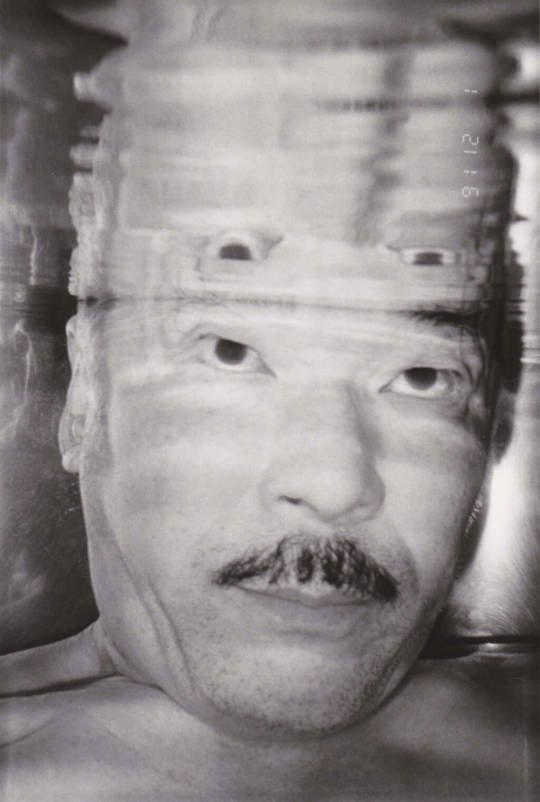
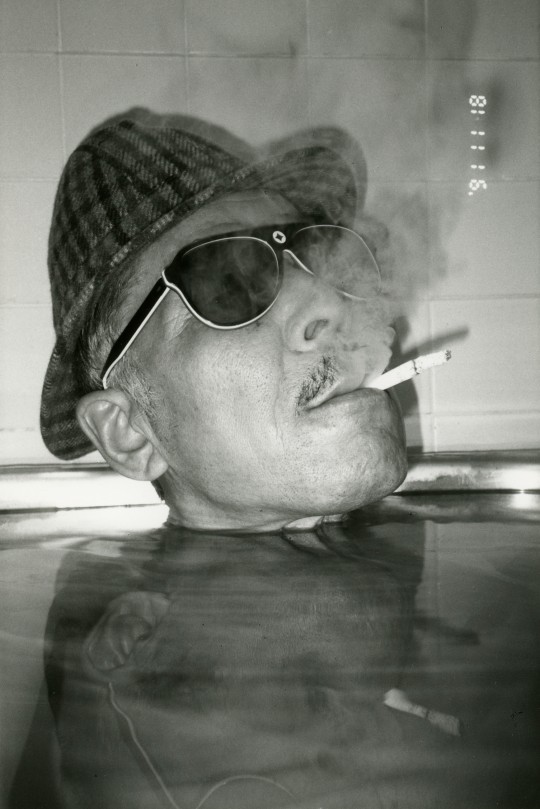
Taken over a two-month period with a Nikonos camera, Bukubuku was Fukase's last ever published photo book, with the prints never seen outside of Japan – instead, remaining secure in a box after they were first shown in Japan in 1992. Hoppen adds, “The work was made on a marvellous camera designed for underwater photography and had a flash incorporated into the camera. The flash, when used, utilises the wonderful refractive qualities that water has. It is quite brilliant in every sense.”
4 notes
·
View notes
Photo

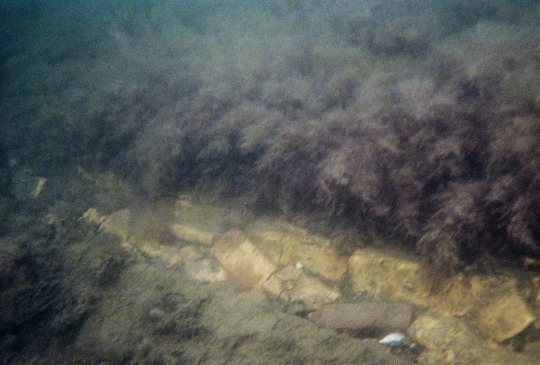
Havmanden, The Merman 2021
Online work for GIBCA
57°46'18.0"N, 11°40'29.0"E are the longitude- and latitude coordinates of the wreck of the Danish frigate Havmanden. In Kjällöfjord, slightly north of Björkö, in the northern Gothenburg archipelago, is the uninhabited island Risö, on which I am standing facing north-northwest. On the horizon, I can see Carlstens fortress in Marstrand, with its characteristic shape of a cylinder on a block. Boats pass through the waterway in a north-south direction. I cannot remember how many times I have sailed this route along the coast heading north. Not once have I reflected upon what lies hidden here, at the bottom of the sea. I lower my gaze from the horizon and face the islet situated half a cable length from the peninsula where I am standing. Between me and the islet, somewhere on the ocean floor, is where it lies: The Danish West India Company’s ship Havmanden that ran aground in 1683.
I prepare myself to dive. From the navigational chart, I conclude that it is about 5-10 meters to the bottom. A depth I should manage to free dive, i.e. to dive without air from tubes. From the smooth Bohuslän rock, I slip into the water and put on my fins, I spit into the swim mask, gently rubbing and rinsing it with salt water to avoid misting on the glass. I wind the film forward in my Nikonos underwater camera, lift my feet from the bottom, and allow myself to float into the strait between the islands. The wetsuit provides me with buoyancy, despite my lead weight belt. I follow the cliff’s extension towards deeper waters. Tufts of seaweed and algae sway in the waves. Sunlight is refracted into rays upon meeting the water and here, close by the surface, the colours of the plants are clearly reflected. I stay close to the surface and swim farther away from land. The bottom disappears into a cloudy haze in tune with sloping downwards, and soon enough I see nothing more than a cyano-coloured soup of organic material and sediment dissolved in the water. The sea of Kattegatt now completely encloses me. I breathe through the snorkel and decide to dive. I take a few deep breaths and finally hold it. I turn in a forward somersault until I am upside down vertically in the water. In a swim stroke, I grab hold of the water and pull myself down. I can feel my feet in the air above the water surface, but soon enough they are also submerged. My journey down is reduced by the buoyancy of my body and wetsuit and I kick with my legs to continue. Soon enough, I have become neutrally buoyant, my density is equal to that of the water, I am neither sinking nor rising. One last kick with my legs and I can feel that I am now sinking by myself. The pressure of the water has compressed the oxygen in my body so that I am negatively buoyant. I continue down but I can still not see the bottom.
The story of Havmanden is multifaceted and complex, with resonance in this day and age. It needs to be told in the entirety of events that resulted in the Danish frigate ending up at the bottom of the sea outside of Gothenburg. My dive is an attempt to evoke an image and a position from an underwater environment, from which a historical horizon can emerge.
During the 17th century, Denmark, as well as Sweden, attempted to advance their positions in the evolving colonial era. At the core was the so-called triangular trade, where plantations in America produced raw materials for Europe. The production was based on slave labour carried out by people kidnapped from the African continent. Slave trade and slave labour was exchanged for profit and technological development in Europe.
Denmark and the Danish West India Company had taken control over the Swedish slave fort Carolusborg (Cape Coast Castle) in Ghana and established other forts along the west coast of Africa in order to bring people across the Atlantic to be sold. Sweden was initially unsuccessful with its colonial expansion and Denmark had a hard time establishing and keeping its colony St. Thomas in the West Indies in order. A life with hardship or death awaited the ones that were forced there.
In 1682, a new Governor, Jörgen Iversen, was appointed to oversee St. Thomas and take control over the activities on the island. In the autumn of the same year, the Danish West India Company, with the support of King Christian V of Denmark, equips the ship Havmanden. The aim of the journey was to transport Danish convicts to St. Thomas and then continue sailing to the west coast of Africa to acquire slaves. Thereafter they were to return to the West Indies with the slaves and then redirect back towards Denmark. Onboard the outward journey was material to build institutions on the island, as well as the 120 convicts that were to be forced to work in the Caribbean. Twenty of them were women convicted of prostitution. It is this captive workforce who, for some months, will come to rattle the hierarchies in the Danish trans-Atlantic trade. On January 20 when the ship is in the English Channel, the prisoners, together with the sailors, make a mutiny. The Governor, the Captain, and five other officials are arrested and killed by being thrown into the sea. When the mutineers seize the ship, they sail to the Azores and release the prisoners. The remaining mutineers plan to sail to Ireland to sell the ship, but conflicts amongst them result in some of the mutineers taking the chance to save their own skin and sail back home to Copenhagen. At the end of March, when the ship enters the Kattegatt, they are struck by a westerly storm and the ship is pushed towards the Swedish coast. The ship manages to pass through the tight passage between the islands Hälso-Källö-Hyppeln to then drop ship anchor in an emergency before running aground at Risö.
The alderman at Marstrand has the five mutineers arrested and taken back to Copenhagen. There they are executed by being tortured and beheaded.
During this time, mutiny was not unusual. However, the mutiny on Havmanden is well-documented and can be read according to the organization of means of production as well as the brutality that Europe’s elite based their prosperity upon. In his thesis, Mutiny in the Danish Atlantic World, Johan Heinsen makes note that there existed a dissonance within the European colonial project, and this was manifested in a conflict such as the mutiny on Havmanden. There are three established ways to understand and analyze mutiny. Firstly, mutiny can be understood from a sort of neurosensory perspective, where the lack of food, water, and heat results in a reaction, a kind of auto impulse, to accommodate basic needs. Secondly,
seafaring per se is an extremely ritualistic place that follows the narrative of a theatrical act of sorts. If the narrative changes, the crew can there and then, consider themselves entitled to seize control of the ship. Thirdly, as a more materialistic reading, mutiny can be based upon a conflict between those who own and rule and those whose labour is being exploited. In this case, the mutiny is justified as the ship should belong to those whose labour the voyage is based upon. All three ways to gain an understanding of mutiny can be applied to Havmanden.
Heinsen also introduces dissonance as a fourth reading of the mutiny, where a conflict arises between the speaker and the hearer. Shipping environments are places governed by sound, as visibility in open seas is filled with emptiness. When Governor Iversen attempts to calm the crew with speech, the subordinates hear something else. They know that within one year on St. Thomas they will most likely die from hard labour, starvation, and illnesses. Whatever the Governor says, this is what they hear.
The sea and underwater environment is in itself a place where cognitive dissonance becomes visible. Places that have nothing to do with each other are tied together through the expansiveness of sea, and within this translocation, profits arise, although they are values created at the expense of another. The sea is also a dangerous place where people cannot live. It is a site for the imagination and dreams, but also death.
The so-called discovery of the New World appears to also have led to some unconscious psychological convulsions in the explorers, whose symptoms are represented in works such as Atlantica (1677) by Olof Rudebeck the Elder. In his text, which is a work of propaganda on the Swedish Empire, Rudebeck explains the origin of Sweden through the myth of Atlantis. Rudebeck sets out to prove that all the world’s knowledge originates in the utopia Plato refers to as Atlantis which would be identical with Sweden. His historical works were dismissed by his contemporaries from the outset as being far too imaginative, but Rudebeck’s preoccupation with historical chronology can be read through the discovery of a New World. After Columbus disembarks in the New World, in one instance Europe becomes the Old World.
A work such as Atlantica can be understood as a symptom of a dynamic that arises between new and old territories, giving rise to speculation about who is entitled to the New World.
The camera in my hand is based on the underwater camera that photographer and adventurer Jacques -Yves Costeau developed when he popularised and medialised the underwater environment in the 50s and 60s. With his research vessel Calypso, he undertook several journeys and created films that became commercial successes, such as Le Monde du Silence (The Silent World) from 1956. In the film, we follow the work aboard Calypso, which is not only a moving diving platform on an undefined sea but also a floating photo lab for still and moving photography. In one passage, Costeau describes the overall intention with the mission, whilst also studying the graph from an echo sounder which, through electroacoustics, maps the depth of the ocean below the vessel. Costeau explains that an echo often appears, as though there is something very large thousands of metres down that has yet to be explained.
Costeau arranges for cameras to be lowered down into the dark to photograph whatever may be down there, and despite the film being developed on-board, he finds no answers. The void appears to be the driving force.
In another scene, the crew is engaged in following a group of whales. Unfortunately enough, Calypso accidentally collides with a whale calf, which is seriously injured. The crew, who feel obliged to kill the injured animal, bring out with ill-concealed delight, the harpoon cannon and kill the calf. What follows is a particularly strange scene, which swiftly tells us something about the unconsciousness of the crew. A group of sharks is attracted to the dead whale and begins to eat at the dead body. Initially, the crew becomes interested in studying the sharks, but suddenly their curiosity turns into fury. In a rage, they go after the sharks that are quite close to the surface, and with hooks, axes, and sledgehammers kill shark after shark. I wonder what it is in this specific homosocial environment that brings forth such affective actions? The sea, the emptiness, the violence - is it the scientists' critical distance and judgment that enables a verdict over the non-human sharks?
Now I sense the bottom. The pressure on my eardrums increases and I have to equalise by pressing air through my nose into my ears. The ocean floor is smooth with some vegetation. Since my time here is restricted to my ability to conserve the oxygen I have in my body, I have decided to photograph straight ahead and indiscriminately. I simply wind up the film and continuously press down the shutter. The camera has been preset, and I now photograph as much as I can.
Then, suddenly, a structure manifests itself. It is two dark lines that criss-cross over the ocean floor. A straight angle is rarely natural. When I come closer I see what it is: two rectangular piles of square stones are sunk into the sand. It can be nothing other than bricks. This is what remains from Havmanden. For 338 years they have rested at the bottom of the sea whilst the shipwreck rotted away.
The bricks filled two functions on Havmanden. Firstly, as a ballast to stabilise the ship whilst sailing. Secondly, once the frigate had arrived on St. Thomas, they were intended to become buildings from which the colony was to be ruled and administered. For a few seconds, I hover over the objects and view them through the glass of the mask. The mask and camera provide me with a sort of optical privilege that is based on the distance between myself and the stones, and between me and history. At the same time, I cannot stop but feel a sense of closeness, we share the same enclosing substance, the sea.
The stones hardly have any vegetation on them, which surprises me. I have a hard time determining their colour as the light of longer wavelengths, such as red and yellow, cannot probe this depth which blue-green can. Everything turns a cyan-colour yet I am convinced that these are not red bricks but yellow-brown. It is said they have the same origin as the bricks in the house Charlottenburg in Copenhagen, where The Royal Art Academy can be found.
The oxygen in my body is running out and the carbon dioxide induces an intense longing to breathe. I stop myself from the impulse to touch one of the stones, as they are subject to the Antiquities Act. Instead, I turn towards the surface and the sun that breaches through the waves. I kick with my feet, find some momentum, and in an instance I am back in the summer coastal landscape. Yet before I can breathe I have to blow the water of Kattegatt out of my snorkel and mouth.
A few weeks later, when I have immersed the film into developing chemicals and then allowed it to dry, I have the opportunity to, at a distance, view the event through the negatives on my light table. It turns out that I have not managed to capture a single sharp image of the wreck of Havmanden. It appears that I have either not held the camera still enough or managed to set the sharpness. Somewhat downcast in spirit I put the negatives aside before recalling Captain Cousteau’s expedition to photograph ghost echoes in the depths of the sea and I decide to look through the images one more time, as if perhaps, there might be something there. I seem to have taken some pictures straight out which, when I scan the images, appears to be nothing more than a tone of blue-green. However, I bring up the contrast and I can then see a refraction running vertically across the image. It is sunlight refracted in the water surface and hits what is called backscatter in the water, and therefore it becomes prominent. The last image from the dive is taken at the same time as I turn away from the bottom and swim upwards, it is photographed straight towards the sun from the wreck. The film on the light table is in itself a surface that lets through light and through it another membrane appears. It is the boundary between air and water that, through the forms of the waves, creates a series of lenses that generate light beams. Just as the film mediates between that at which a given moment has taken place, with certain specific requirements, the sea surface appears to create a boundary between different states. This dividing line can be likened to photography’s making of disparities, which appears to elicit both distress and possibilities, ultimately introducing a crisis. I recall one final scene from The Silent World where Cousteau says the imperative sentence “Sometimes a marine biologist must use dynamite on a coral reef”, meaning that in order to scientifically count how many fish there are in a coral reef he must explode dynamite to kill them all – taking photographs is not accurate enough. The explosion in this scene resembles a miniature version of the French nuclear test from the Mururora atoll in the Pacific during the 1960s. Cousteau acknowledges what he is doing as an act of vandalism, but also states that this needs to be done in the name of science. This type of reasoning can be understood through theorist Ariella Azoulay´s text Unlearning decisive moments of Photography, where she links the colonial ideology of the imperial right to take photographs to the imperial right to destroy existing worlds and the right to manufacture a new world.
As it turns out the realm of the underwater is not silent at all, but rather a world of dissonance.
3 notes
·
View notes

